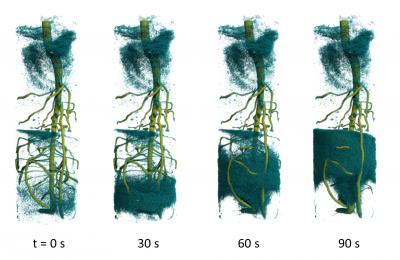A team from Potsdam, Berlin and Grenoble was able to visualize the transport of water in soil as well as through roots of lupine plants using ultrafast 3D neutron imaging

Credit: C. Tötzke/Uni Potsdam
Water and nutrient uptake by plants involves dynamic and complex interactions of roots with the surrounding soil. “The tomographic method makes it possible to track 3D water paths from soil into roots over time,” says Dr. Christian Toetzke, who heads the research team at the University of Potsdam. “These insights can help to develop strategies for more efficient and sustainable use of water and fertilizer in crop cultivation.”
Neutrons are sensitive mainly to light elements such as hydrogen, lithium and their compounds. Neutron tomography can therefore be used to precisely map water content non-invasively, both in the roots and in the surrounding soil of a sample. How plants can take up water and nutrients depends largely on the properties of the rhizosphere, a few millimetres thick soil layer surrounding the roots. This region not only delivers the mineral and organic components from soil to roots, but is also influenced by root exudates and microbial activity.
Until now, the acquisition of 3D neutron images took at least ten seconds per tomogram. This still resulted in a limitation to study rapid processes such as the infiltration of the root system with water. To enable more images in a shorter time, a team led by HZB expert Dr. Nikolay Kardjilov optimized the method at NeXT-Grenoble, a recently opened tomography instrument of the Laue-Langevin Institute (ILL), which is supplied with cold neutrons by a 60 Megawatt research reactor. By exploiting the much more intense neutron beam, it has been possible to reduce the recording time per tomogram to almost one second. “The result even exceeded our expectations,” explains Toetzke: “The achieved acquisition rate was higher than assumed beforehand. Nevertheless, the signal-to-noise ratio and the spatial image resolution could be improved also”.
Now that the technical capabilities of ultrafast neutron tomography have been demonstrated, Kardjilov and his team are working on further improving the method and establishing its application in other research areas. Since the Berlin neutron source of the HZB will cease operation in December, the fast imaging set-up will be integrated into the NeXT instrument in Grenoble in order to be able to investigate fast transport processes in other materials in the future. For example, high-speed neutron tomography could provide new insights into the hydraulic fracturing of porous rock formations or could be used to investigate ion transfer during fast charging and discharging of lithium batteries in order to increase the safety, capacity and durability of such energy storage systems.
###
Media Contact
Antonia Roetger
[email protected]
Original Source
https:/
Related Journal Article
http://dx.




